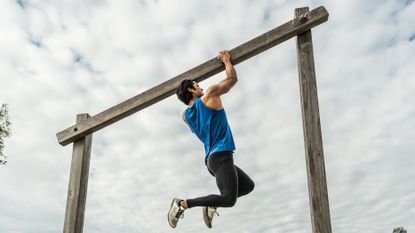Even if you aren't interested in joining the US Army, you might want to give the Army Combat Fitness Test (or ACFT) a try. I tried hand-release push-ups before, but the rest of the exercises are also challenging to do. In fact, some of them are so challenging that the Army just replaced one of the exercises, the infamous leg tuck, with planks, so fewer people fail the ACFT.
This is just one of the many changes introduced as part of a recent push to make the ACFT more inclusive. As explained on military.com, "The most significant change to the six-event ACFT is that it's no longer meant to prepare soldiers for combat but instead built as a general fitness assessment. It will also have different scoring standards for men and women across different age groups, in most cases lowering them."
The original ACFT had the same standards for both women and men, but following a congressionally mandated report from Rand Corp, a Washington D.C.-based think tank found that "nearly half of the service's women could not pass earlier standards for the test" and especially struggled with leg tucks.
What's a leg tuck anyway, and is it that hard to do them? I gave them a try to find out.
Army Combat Fitness Test leg tucks: What is it?
The leg tuck was criticised the most as many people found it hard to perform this core exercise. According to the ACFT scoring standards, you have to be able to complete one repetition of the movement to pass the test, at least the leg part of the test. To achieve maximum points, you'd have to be able to do 20 reps without letting go of the bar.
To perform a US Army-standard leg tuck, grab the bar with an alternating grip at the midpoint of the pull-up bar, legs off the ground. From here, you bend the elbows and tuck the legs close to your chest until you end up looking like you're in a fetal position, only hanging from a bar. Finally, you must return to the starting position before starting another rep.
It's important not to cross the legs as in combat situations, you might have to jump off a wall or a helicopter quickly, and you might trip over if your legs are crossed.
Here is a short explainer video that might make it easier for everyone to visualise how the ACFT leg tuck is done:
Is it hard to do Army Combat Fitness Test leg tucks?
Naturally, after reading the news, I couldn't wait to head out to the nearest park with a pull-up bar to give the leg tuck a try. It doesn't seem too challenging to perform, and after all, I did the 100 pull-ups a day challenge, so I was pretty confident I could do at least a few leg tuck reps before my grip gave in.
To my surprise, leg tucks are not easy to perform. It's different from doing pull-ups and knee-ups separately; with leg tucks, you have to use almost all muscles in your body at each rep which is admittedly tiring. Not to mention, most people who say they can perform chin-ups or pull-ups usually don't return to the proper hanging position after each rep, meaning that if the person scoring your leg tucks is strict, you might end up scoring a big fat zero for the exercise.
Many soldiers complained about having a solid core but not being able to hold themselves on the bar for long enough. Grip strength is no joke, and there are a number of exercises that can improve it. Some of the best exercises to improve grip strength are kettlebell swings, deadlifts and farmer's carries. When I did the 10,000 swing kettlebell workout challenge, my grip strength significantly improved after two weeks, so that's an opinion if you don't mind your workout being repetitive.
Was it a good idea to replace the leg tuck with planks?
An important thing to note about the new test is that it's designed to measure fitness, not combat readiness. Well, if you're fit enough to score well on the ACFT, you're probably physically fit enough to fight, but that's beside the point.
The plank is a great bodyweight exercise, and it does require a lot of core strength, so if the ACFT aims to measure fitness, the plank is an excellent option to do that, probably a better option than leg tucks. The latter exercise heavily relies on the person having good grip strength, not something an average soldier trains a lot (I'd assume).
I don't mind leg tucks, but I don't have to do them to pass any tests; I just do them for fun. If I was a soldier and my future in the army depended on being able to perform 15 leg tucks, I might think differently.



